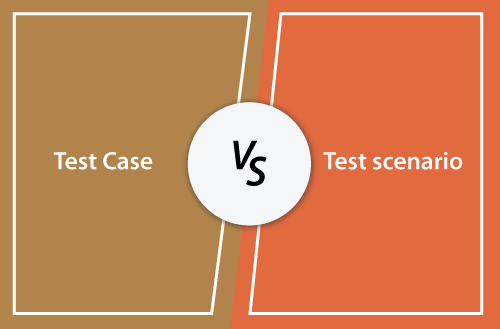In this section, we are going to discuss the difference between the Test Case and Test Scenario as we understood that both the test case and test scenario are part of Testing documentation.
As test engineers, we must be aware of these two testing terms as they play a major role in the Software Test Life Cycle's Test Design and Test Execution phases.
But before we see the difference between Test Case and Test Scenarios, first, we will understand the definitions of Test Case and Test Scenario.
What is a Test Case?
The test case is an in-details document that includes all possible inputs such as positive and negative, and the navigation steps. These are implemented during the testing process to check whether the software application is performing the task for that it was developed or not.
What is Test Scenarios?
It is a detailed document of test cases that cover end to end functionality of a software application in liner statements. The test scenario is a high-level classification of testable requirements. Before performing the test scenario, the test engineer needs to consider the test cases for each scenario.
Difference between Test case and Test Scenarios
In the below table, we have listed some of the important difference between test case and test scenarios:

|
S.NO |
Test Case |
Test Scenarios |
|
1. |
The test case is a
detailed document, which provides information about the testing
strategy, testing process, preconditions, and expected output. |
The test scenarios
are those derived from the use case and give the
one-line information about what to test. |
|
2. |
It includes all
the positive and negative inputs, navigation steps, Expected results,
pre and post condition, etc. |
Test scenarios are
one-liner statement, but it is connected with several test cases. |
|
3. |
These are low-level
actions. |
These are high-level
actions. |
|
4. |
The main objective
of writing the test case is to verify the test scenario by implementing
steps. |
Writing the test
scenario's main objective is a cover end to end functionality of a
software application. |
|
5. |
It takes more
time as compared to test scenarios. |
It takes less
time as compared to test cases. |
|
6. |
The test cases
are hard to maintain. |
Test scenarios
are easy to maintain due to their high-level design. |
|
7. |
The test case will
help our in-depth testing of the application. |
The test scenario
will help us in an agile way of testing throughout the functionality. |
|
8. |
The test case is
work on the basics of "How to be tested". |
The test scenarios
are work on the basic to "What to be tested". |
|
9. |
To write the test,
we need additional resources to create and perform test cases. |
Fewer resources are
sufficient to write test scenarios as compared to the test cases. |
|
10. |
In a test
case, we mainly focus on the document details. |
In test
scenarios, we will focus on thinking and discussing details. |
|
11. |
It can obtain
from test scenarios. |
It can obtain from
the use cases. |
|
12. |
If the test engineer
is working offside, then the creation of test cases is significant. |
If the tester is
particularly working in Agile methodology, then creating test scenarios helps
us in a time-sensitive situation. |
|
13. |
Writing test cases
is a one-time attempt that can be used in the future at the time of
regression testing. |
The test scenarios
are a time saving process; that's why it is preferred by the new generation
of software testing community. |
Conclusion
Using
both the test
case and test scenario together ensures robustness and high coverage
testing creativity.
It's
the best exercise if we write Test
Scenarios first and then write the Test Cases because
most IT companies prefer Test Scenarios in today's Agile time. In the agile
era, the test case is being replaced with test scenarios to save time.



0 Comments